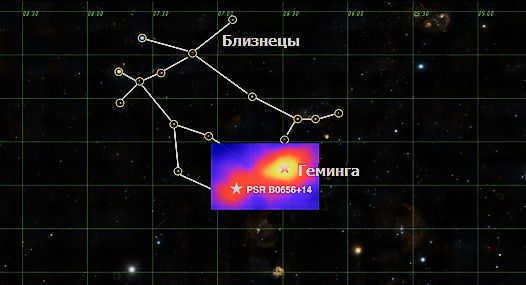A well-known constellation in the night sky is Orion, which can be easily identified by its three aligned stars. In close proximity to Orion lies another constellation that rivals it in size and brightness – Gemini. Gemini is part of the zodiac constellations and boasts a distinctive and easily recognizable pattern. It consists of two parallel lines of small stars, with bright “dots” at each end. These lines culminate in the prominent stars Castor and Pollux. The good news is that this constellation can be observed from any location in our country. The best time to appreciate Gemini is during December and January, when it is situated high enough above the horizon and offers excellent visibility.
There is a captivating legend surrounding the origins of this constellation. A young maiden entered into matrimony with a man and bore him children, among them Polydevk (Pollus). However, fate intervened and the same maiden found herself falling in love with Zeus, resulting in the birth of Polydevk’s half-brother, Castor. While they were not biologically twins, it mattered not, for they were inseparable, spending every waking moment together and harboring a love greater than that of their own parents. Sadly, Polydevk was mortal, and one day he succumbed to death. Castor, overcome with grief, beseeched his father to grant him the same fate, but Zeus, reluctant to lose his son, showed mercy. He permitted Castor to venture to the mortal realm of Hades each night, allowing the brothers to continue their bond. Their strength and valor were renowned, prompting Zeus to etch a constellation in the heavens depicting two young men, armed or joyously laughing.
The constellation of Gemini is truly worth your attention, as every year all the planets in our solar system, as well as the Moon and Sun, pass by it. There are approximately 90 stars in Gemini that can be observed with the naked eye, and with the help of powerful binoculars, you can even see a stunningly colorful nebula nearby. I highly recommend taking a moment to gaze at the night sky – it is an awe-inspiring experience.
Alternative 2
Gemini is a member of the zodiacal constellations and can be found in the northern hemisphere sky, situated north of the Orion constellation. It shares borders with Taurus, Unicorn, Lynx, and the Small Dog. Gemini is visible during the initial two months of winter and the Sun enters the constellation between June 20 and July 20. The area covered by Gemini spans 514 square degrees.
According to Ptolemy, the mention of this group of stars dates back to the 2nd century. It is widely believed that the constellation Gemini was named after its two brightest stars, Castor and Pollux. These stars were given their names due to an ancient Greek myth involving twin brothers from Troy, Castor and Pollux. Although they shared the same mother, they had different fathers. Castor was the son of Tyndarus, while Pollux was the son of Zeus, who granted him immortality. When Castor died in battle, Zeus decided to bestow immortality upon him as well. The two brothers were then immortalized as a constellation in the night sky, known as Gemini.
The constellation Gemini contains a total of 134 stars. These stars are arranged in two parallel lines. The brightest stars in Gemini include Pollux, Castor, Alchena, Tejat Posterior, and Mebsuta. Additionally, the Messier cluster can also be found within this constellation.
To the north of Pollux lies Castor, which serves as the head of another celestial twin. It has a magnitude of 1.59m and is located in the α Gemini constellation. Castor is situated more than 50 light-years away from Earth and is a triple system.
Representing γ Gemini is Alchena, with a magnitude of 1.93m. Alchena is classified as a white subgiant and is separated from our planet by over 108 light-years. It shines with a brightness 120 times greater than that of the Sun.
Tejat Posterior symbolizes the leg of one of the Gemini brothers. With a magnitude of 2.85m, it is a red giant located in the μ Gemini constellation, approximately 230 light years away from Earth.
Mebsuta, with a magnitude of 2.98m, is the ε star of the Gemini constellation. It is a supergiant situated almost 850 light years away from our planet. Mebsuta shines nearly 9 times brighter than the Sun.
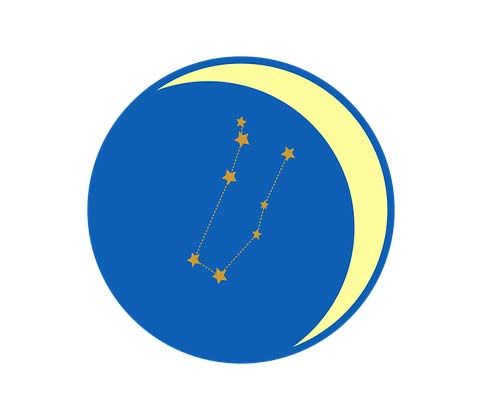
Today’s Hot Topics
A bicycle is not just a mode of transportation. Riding a bike is a fantastic recreational activity enjoyed by both kids and adults. However, it’s important to be aware that riding a two-wheeler can be risky.
Peat is a truly remarkable organic mineral. It forms when plant remains decompose in oxygen-deprived conditions.
Aloe is a perennial herbaceous plant from the Asphodelaceae family. It is classified as a succulent and has a compact stem with juicy, fleshy leaves. The leaf edges can either be smooth or serrated.
The widespread construction of castles in Europe began in the 9th century. Typically, castles were built near rivers, often on elevated banks, providing natural protection.
Gemini is a highly noticeable constellation, even for novice stargazers, due to its vibrant reddish hue.
The exploits carried out by the siblings:
Pollux and Costorus are precisely the two siblings who served as the foundation for the Gemini constellation. Pollux was an incredibly powerful and courageous athlete who excelled in hand-to-hand combat. Castor had a natural talent for handling chariots. There exists a tale of how these two siblings ingeniously absconded with two brides directly from the wedding venue in order to marry the exquisite ladies themselves. Without hesitation, they successfully accomplished this feat, thereby becoming bitter adversaries to the former grooms of their current wives.
This constellation covers an area of 514 square degrees and is ranked as the 30th largest in terms of magnitude. The arrangement of stars in the zodiacal position actually resembles two human figures, namely two brothers. The constellation is a parallel assemblage of stars and can be located to the northeast of the Orion constellations.
There is a massive meteoroid stream near one of the stars in this constellation, known scientifically as Himinida. This cluster of meteoroids can be seen at the start of December. On December 13th, there is an exceptionally high density of meteoroids in the sky, with over 60 visible pieces!
To witness the breathtaking beauty of this constellation, children must exert a touch of determination. Gemini stands out as one of the most radiant and prominent constellations within our solar system. It is typically visible during the winter season, predominantly on January evenings. By August, this constellation commences its ascent in the eastern sky after sunrise. During May, Gemini can be easily spotted in the western sky, just before daybreak. Each year, the Sun, the most dazzling celestial body in our galaxy, aligns with this constellation. This remarkable event occurs on June 21, when Gemini sits high above the horizon, displaying its splendor from every corner of our planet.
Wrapping up the article, we have gained further insights into this remarkable constellation, the composition of which is essential knowledge for individuals of all ages. For youngsters, this knowledge will prove to be highly beneficial and incredibly thrilling. The article will serve to broaden their horizons. Familiarity with ancient legends aids in providing vivacity while exploring the environment, just as a poet can infuse vibrancy into a poem by depicting a captivating landscape. By cultivating a deep interest in astronomy from an early age, one can become an intellectually refined individual by the time adulthood is reached.
The Gemini Constellation
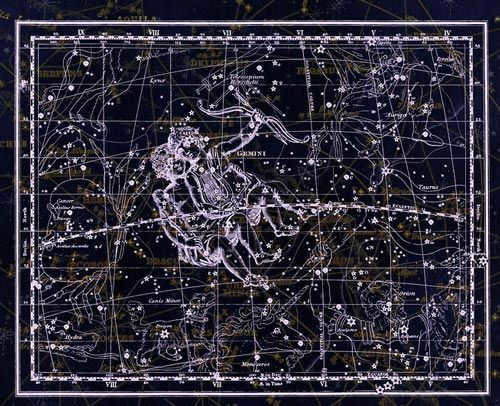
The city of St. Petersburg holds a unique position among the cultural hubs of Russia. It gained global recognition thanks to the abundance of historical and architectural landmarks not only from our own country.
The bat is the sole creature capable of soaring through the atmosphere, which might classify it as a bird. However, it possesses a distinctive trait – it does not nurse its offspring with milk.
Distinctive shapes formed in the celestial realm by radiant stars were traditionally referred to as constellations. They were associated with captivating myths and significant prophecies. One of the most extraordinary constellations is Gemini. This article will outline intriguing facts about it.
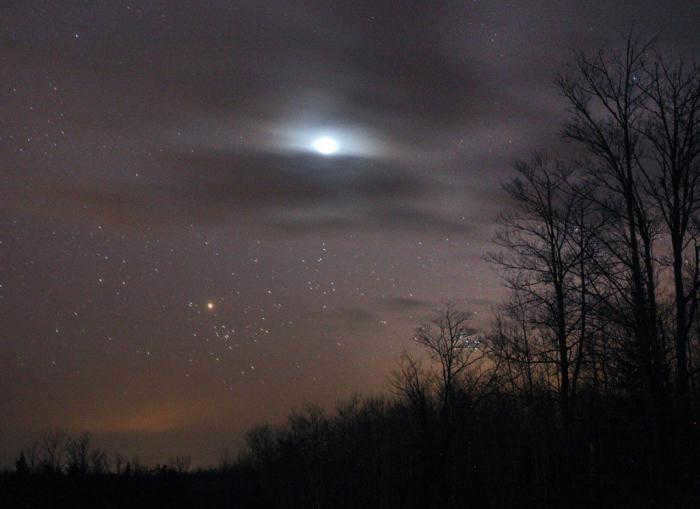
Constellation Description
The constellation Gemini can be described as follows. This part of the celestial sphere is positioned at a right angle to the Milky Way. The stars that make up the constellation form an almost perfect rectangle shape. On a clear night, approximately seventy stars can be observed with the naked eye. The brightest stars in this constellation are known as Castor (referred to as the “coachman”) and Pollux (known as the “fist fighter”). The other stars in the constellation are arranged in two parallel chains. However, it is challenging to visually perceive the picture often depicted in ancient star atlases, which portrays two inseparable twin brothers embracing one another. Modern constellation charts do not depict such an image either.
Indeed, Castor is a intricate arrangement of various celestial bodies. Its proximity to the Sun is nearly 46 light-years. Pollux, on the other hand, is a colossal yellow-orange star with a luminosity thirty-five times greater than that of the Sun. It possesses a significantly lower temperature compared to its stellar sibling. To reach this shining entity, one would have to traverse a vast distance of thirty-five light-years.
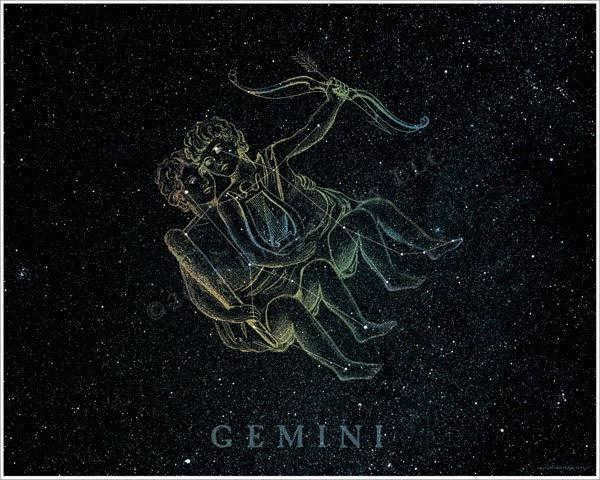
Fascinating Discoveries in Gemini
Within the Gemini constellation lies an array of captivating celestial objects. Some of these objects are visible to the naked eye, while others require more advanced equipment for observation. Scientists are particularly fascinated by the U (ipsilon) star in Gemini, which possesses unique properties. Classified as a variable cipheid, this luminary experiences periodic fluctuations in brightness. These fluctuations occur every 102 days and are caused by powerful explosions on the star’s surface. By examining constellation charts in detail, one can observe that this star is situated in the location where the “heart” of Pollux should reside.
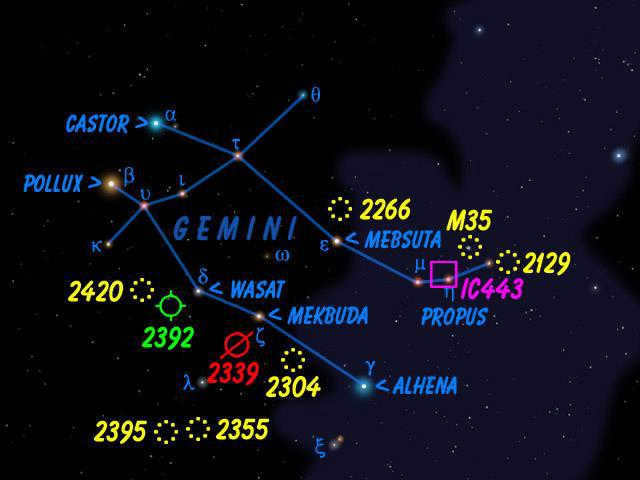
Fascinating Things. Shooting Stars and Celestial Clouds
The radiant of a meteor shower known as the Geminids can be found near Castor in the Gemini constellation. This celestial event can be observed from December 7 to December 15, with the peak activity occurring on December 13. During this time, up to 60 shooting stars can be seen per hour.
If you look near the stars Mu and Zeta Gemini, you might notice a faint cluster of stars with the naked eye. This cluster, known as M35, consists of 120 stars and is particularly captivating when observed through a telescope or binoculars. It is located approximately 830 parsecs away from the Sun.
One more intriguing object worth studying is the Clown Nebula, also known as the Eskimo Nebula (NGC 2392). Scientists have given this star of tenth magnitude its imaginative names due to its unique appearance: a bright and uniform dust shell surrounds it. The Clown Nebula is situated at a distance of 2900 light years from the Sun.
Research History
Throughout history, explorers and sailors have relied on celestial bodies for navigation. Different cultures have assigned various names to the stars in the sky. However, there have always been two prominent stars that have been seen as inseparable. According to Greek mythology, these stars are known as the Dioscuri – Castor and Pollux – the sons of the Spartan king Tindareus and the Olympian god Zeus. This particular region of the night sky is included in the astronomical catalog called “Almagest,” which was compiled by Claudius Ptolemy in 140 AD. The ancient Babylonians also considered this constellation as a pair that cannot be separated. They referred to the brightest stars in it as the “shepherd and warrior.” The Thracians believed that these stars were twins who aided sailors in finding their way back home.
In the field of astronomy, Gemini is linked to two significant scientific breakthroughs. In 1781, W. Herschel made the discovery of the planet Uranus, which was located near the bright star Propus within this constellation. Another notable explorer, C. Tombaugh, went on to discover Pluto in 1930, a celestial body that is in close proximity to the star Vasat, which is also a part of the Gemini constellation.
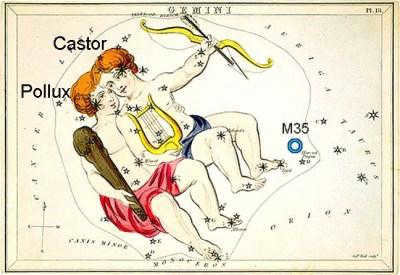
Observation
Finding the Gemini constellation in the night sky may pose a challenge for children. However, it is relatively simple to locate. The constellation stands out prominently with its distinct pattern of parallel chains of stars. To find Gemini, look to the northeast of Orion. The constellation of Ascendant should be located northwest of the Gemini “parachute”. Gemini is part of a group of prominent constellations that can be seen in the sky, including Taurus and Leo.
In January and December, you have the opportunity to observe the Gemini constellation. It is during these months that the Sun enters this constellation, making it visible from all parts of our country. On June 21st each year, the Sun reaches its highest point in the sky, making the Gemini constellation easily visible to all.
Mythology. The Origins of the Brothers
The constellation Gemini is filled with tales and myths. Children will find it particularly fascinating to learn about the ancient legends surrounding it. In ancient Greece, it was believed that Leda, the wife of the formidable Tyndareus, king of Sparta, was the mother of the famous brothers. Leda was renowned for her exquisite beauty and captivated not just mortal men, but also the gods of Olympus. Even Zeus himself couldn’t resist her charm. To avoid any conflict with his wife, Hera, the goddess of the family hearth, Zeus transformed into a white swan and flew to Leda. Soon after, she gave birth to two divine children: a daughter named Helen the Beautiful, whose beauty sparked the Trojan War, and a son named Polydeucus (Pollux). Leda later had two more children with her husband: a son named Castor and a daughter named Clytemnestra. The brothers were inseparable in their childhood, but their destinies took different paths. Zeus bestowed immortality upon Polydeucus, while Castor remained a mere mortal.
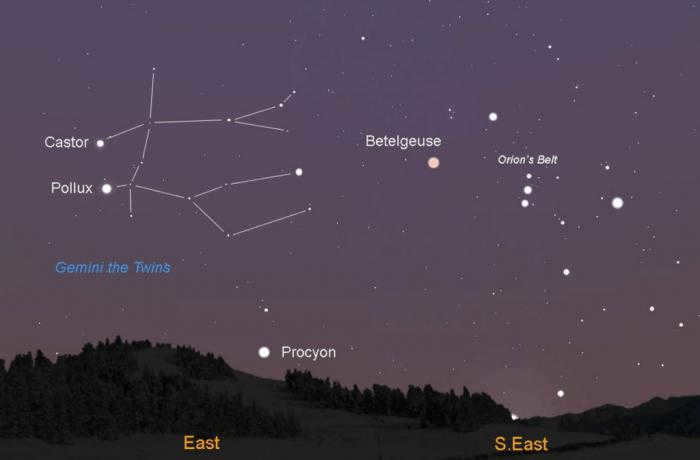
Mythology. Heroic Exploits
According to the mythology of the Gemini constellation, the brothers grew up to become remarkable athletes. They accomplished numerous renowned feats. The Dioscuri aided Jason in obtaining the golden fleece. Castor was an unparalleled charioteer and skillfully controlled chariots. Pollux was an unbeatable boxer. The brothers always acted together. One day, they abducted the sisters Theba and Gelaira, who were the daughters of King Livkippus. The boys managed to steal the girls right from under the king’s nose and married them. Polydevk chose Theba, while Castor chose Gelaira. As a result, the brothers of the Apharetides, Idas and Linkeus, whose brides were stolen by the Dioscuri, became their sworn enemies. In battle, Idas once killed Castor.
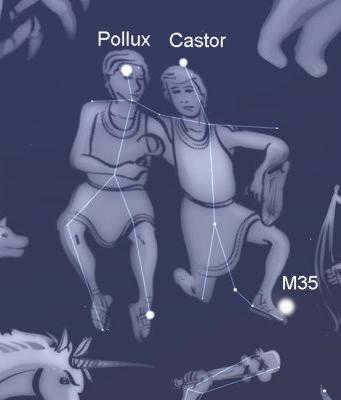
Mythology. The Love Between Brothers
There is a fascinating tale about the brothers that explains the origin of the Gemini constellation. This particular part of the story holds great significance, especially for young children, as it showcases the importance of selfless love between siblings. After Castor’s death, Polydevk approached Zeus with a heartfelt plea to become mortal. He was willing to reside in the dark depths of Hades forever, just to never be separated from his beloved brother. Zeus, feeling compassion for his son, granted Polydevk’s wish. However, there was a catch – Polydevk was to spend one day in Olympus and the next in the realm of the dead. The ancient Greeks held these inseparable twins in high regard, considering them as patrons and protectors of humanity. Witnessing the unbreakable bond between Polydeucus and Castor, Zeus transformed them into stars and positioned them in the heavens, serving as a perpetual reminder of loyalty and brotherly love.
Conclusion
Our article aims to provide a concise overview of the Gemini constellation. This information is particularly valuable for children as it helps broaden their knowledge and improve their understanding of the world. Exploring ancient myths adds a poetic element to the study of the night sky. By delving into astronomy, you will embark on a journey of exciting discoveries!
Let’s delve deeper into this topic, explore its historical origins, and uncover some intriguing facts.
Appearance of the Gemini constellation
The Gemini constellation has the shape of a rectangle. This formation becomes visible when the brightest stars are mentally connected.
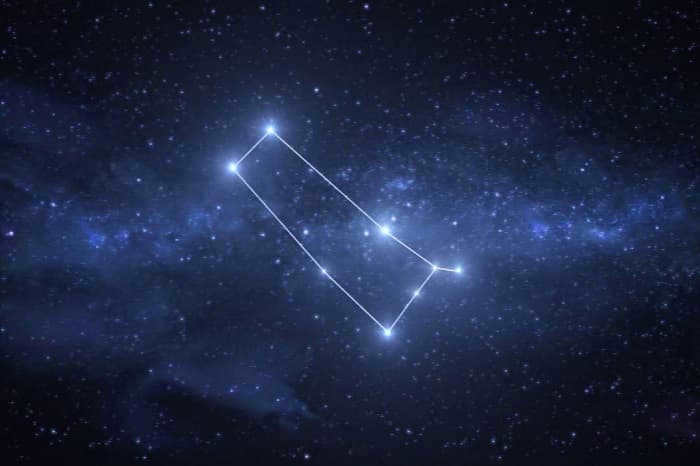

The symbol of the constellation, which consists of two connected vertical lines, originated from this point. Other stars are also present in the mental rectangle next to it, but they are not as prominent.
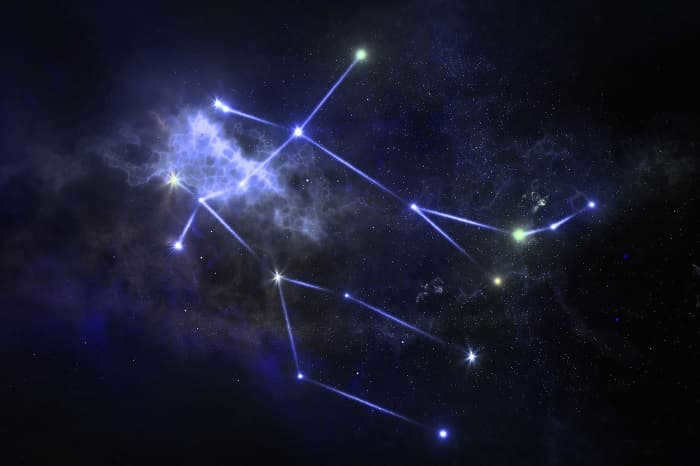
When looking at maps and charts, Gemini is portrayed as the silhouette of two individuals, seemingly connected by hand.
Mythology and historical significance of the constellation
The interpretation of Gemini varied across different cultures. Some depicted the constellation as a male and female figure, while in ancient Babylon, it represented a shepherd and a warrior. The ancient Greeks, on the other hand, saw it as the embodiment of inseparable brothers.
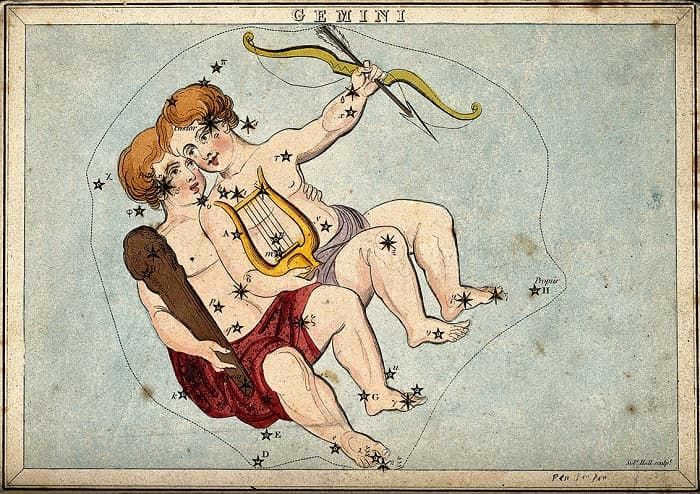
Legend has it that these brothers were featured in ancient Greek mythology.
These twins were born to Leda, the wife of Spartan king Tyndareus, who was said to be incredibly beautiful. Even Zeus himself could not resist her allure. However, Zeus was concerned about the potential jealousy of his wife Hera, the goddess of the home, so he transformed into a swan and flew to Sparta in order to meet Leda.
Leda and Zeus had two children together – Polydevk (Pollux) and Helen the Beautiful, whose beauty ultimately sparked the Trojan War. Leda also bore two children by her husband – Castor and Clytemnestra. Zeus bestowed immortality upon his own son, Polydeucus.
Despite having different fathers, the brothers were inseparable throughout their lives. They even married their own sisters, Phebe and Gillaira. However, in order to do so, they had to abduct the girls from their suitors, Linkeus and Idas.
There are two different explanations for the death of Castor. According to one version, he was murdered by his cousin Idas. According to the other version, he was killed by his rival Idas. Polydevk was deeply saddened by the loss of his brother. He was unwilling to be separated from him and therefore pleaded with Zeus to grant him mortality so they could live together in the underworld.
Zeus agreed to Polydevk’s request, but with the condition that he would spend one day in Olympus and one day in the realm of Hades. However, Zeus soon realized the intense bond between the brothers. As a result, he transformed them into stars, ensuring that they would never be apart.
The celestial bodies of the Gemini constellation
The most prominent stars within this constellation are Pollux, also known as beta Gemini, and Castor, which is designated as alpha Gemini. The stars in this constellation are ranked by brightness using the letters of the Greek alphabet.
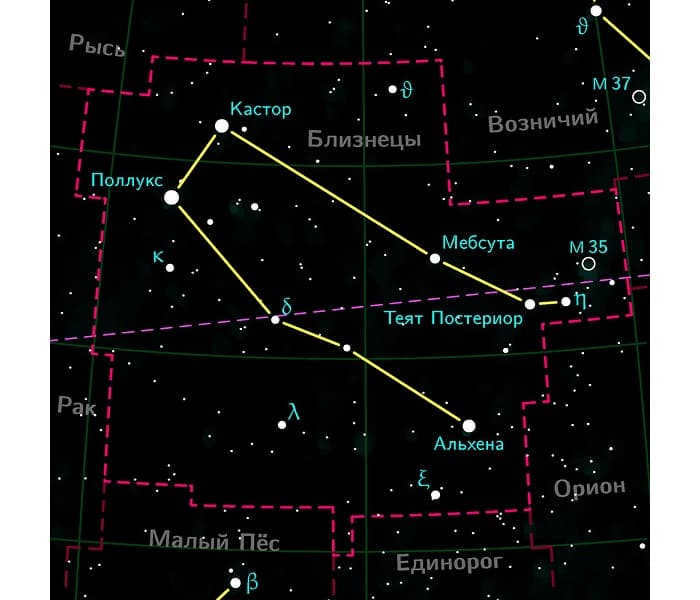
In this particular instance, the arrangement of the designations is slightly different.
The most luminous star is Pollux. It is positioned 33.7 light-years away from the solar system. The second most luminous star is Castor.
Castor is a rather extraordinary star. It can be classified as a multiple star system, meaning it consists of multiple stars. In this specific case, Castor is composed of six stars. As a result, Castor belongs to multiple spectral classes simultaneously (stars are classified into spectral classes based on their temperature).
Alchena is visible to the naked eye and is situated directly across from Pollux.


In addition, there are numerous other stars within the Gemini constellation. A few of these stars are visible with regular binoculars, while others can only be seen using a high-powered telescope.
Aside from stars, the Gemini constellation also encompasses the Eskimo planetary nebula (NGC 2392) and the M 35 diffuse star cluster.
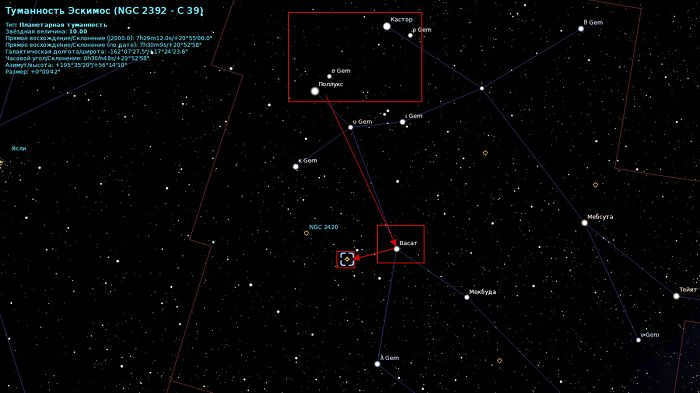
There have been discoveries of planets in various stars.
Observing Constellations
During the time period from late autumn to spring, one can observe the constellation Gemini. Professional astronomers locate celestial objects using coordinates. For beginners, it is recommended to learn how to find desired objects by referencing other stars and constellations.
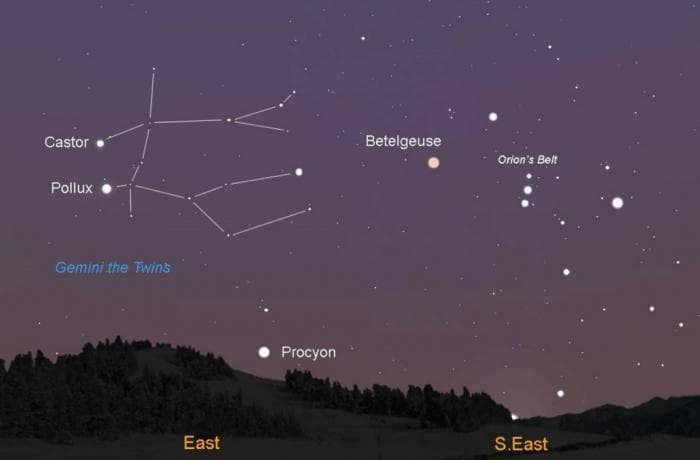
Finding Gemini is a simple task when looking at the constellation Orion. It can be seen in the eastern sky.
It is important to note that the time of observation plays a significant role. For instance, during early winter, Orion can be seen in the east shortly after sunset. However, as the constellations move across the sky, it will already be in the southern sky before dawn.
If you examine a picture or photograph of the night sky, you will notice that the brightest stars of Orion form two triangles with a belt of three stars in the center.
Gemini can be found northwest of Orion. The key marker for identification is Orion’s upper bright star, Betelgeuse. It points towards Pollux.
Astronomy Stars that shine the most in the night sky ⭐ their positions, shades, and names of the primary and secondary brightest celestial objects, a compilation of constellations used for navigation in space that are characterized by their white, red, and blue hues.
Astronomy The Sun-centered model of the universe ☀️ the person who first proposed this theory, evidence supporting the idea of the Earth revolving around the Sun, the benefits and fundamental concept of this model, as well as its proponents and critics.
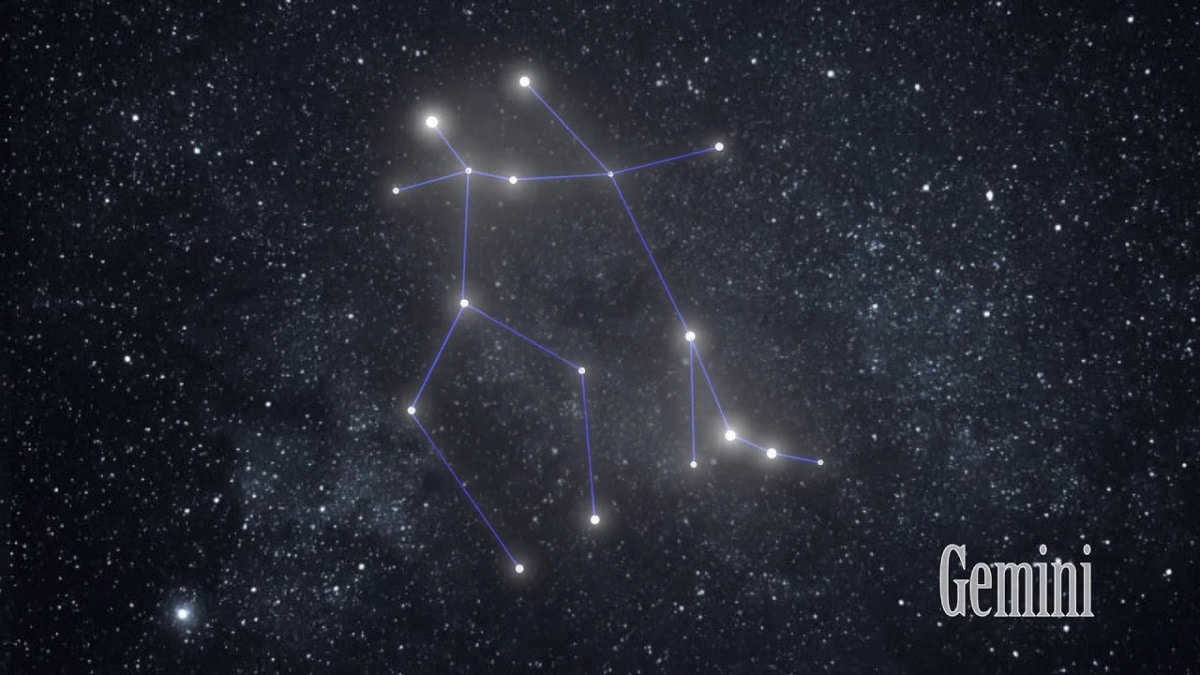
Today, we will be discussing one of the most significant constellations in the Zodiac due to its relevance and position. We are referring to the Gemini constellation. Situated approximately 30-30° northwest of Orion, which happens to be the most prominent and brightest constellation in the sky, Gemini is relatively easy to spot. This constellation has numerous captivating tales from Greek mythology that are worth exploring.
Therefore, this article will focus on providing you with comprehensive information about the attributes, whereabouts, and mythology associated with the Gemini constellation.
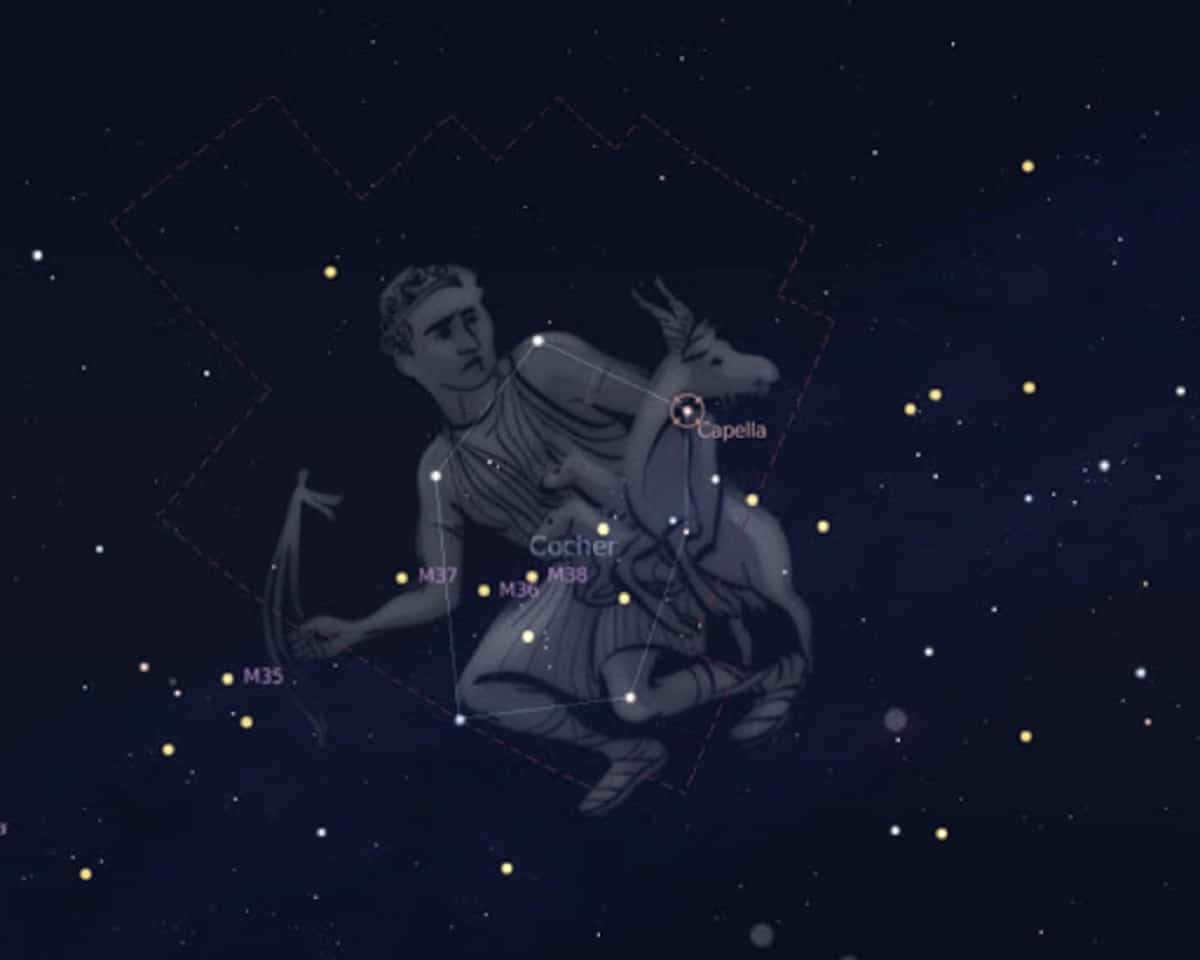
This constellation, located approximately 30 degrees northwest of Orion, is considered the third most significant in the zodiac. Orion, known as the “space hunter,” is the most prominent and brightest constellation visible in the night sky. Gemini, on the other hand, consists of a cluster of stars that may appear close together to the human eye, but in reality, they are separated by several light years or have no physical connection at all.
Ancient astronomers, in an effort to make sense of these distant stars, decided to connect them with imaginary lines, creating various patterns, objects, and figures that were then assigned constellation names. Thus, Gemini came into existence as a representation of polarities.
Gemini: A Guide to its Location and Composition
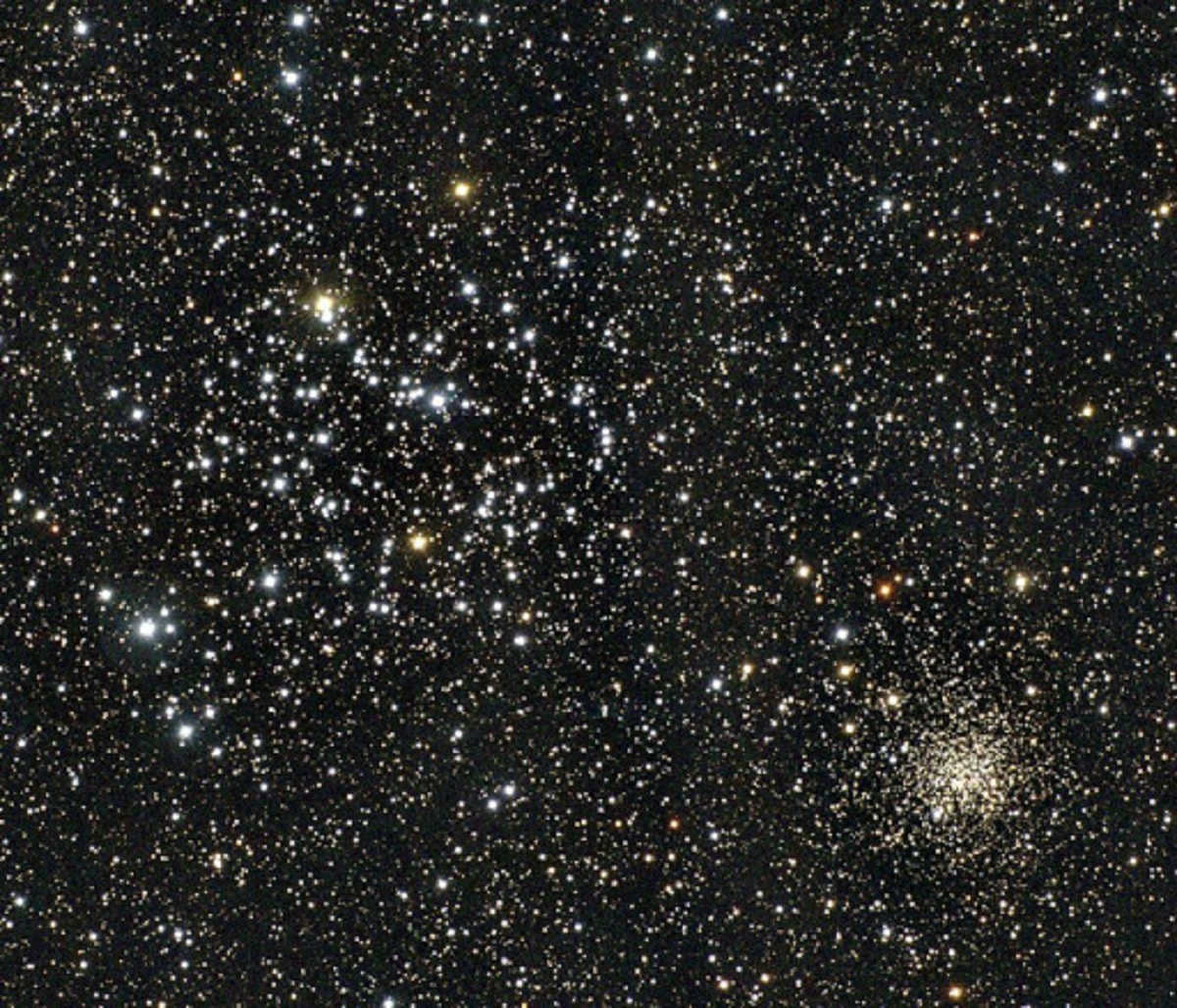
The Gemini constellation can be found approximately 30 degrees northwest of Orion, the celestial hunter. Among the notable characteristics of this constellation, the following stand out:
- The two most significant stars are the brightest and most prominent. One of these stars is known as Castor, and the other is called Pollux. It is thanks to Pollux that a planet beyond the Sun’s orbit was discovered. This star is quite massive, having a size more than three times that of Jupiter. Castor, on the other hand, is classified as a multiple star system with six components.
- This constellation showcases shining white stars during certain orbital periods. It is also one of the constellations belonging to the Zodiac and ranks as the third most significant.
Legend of Gemini in Mythology
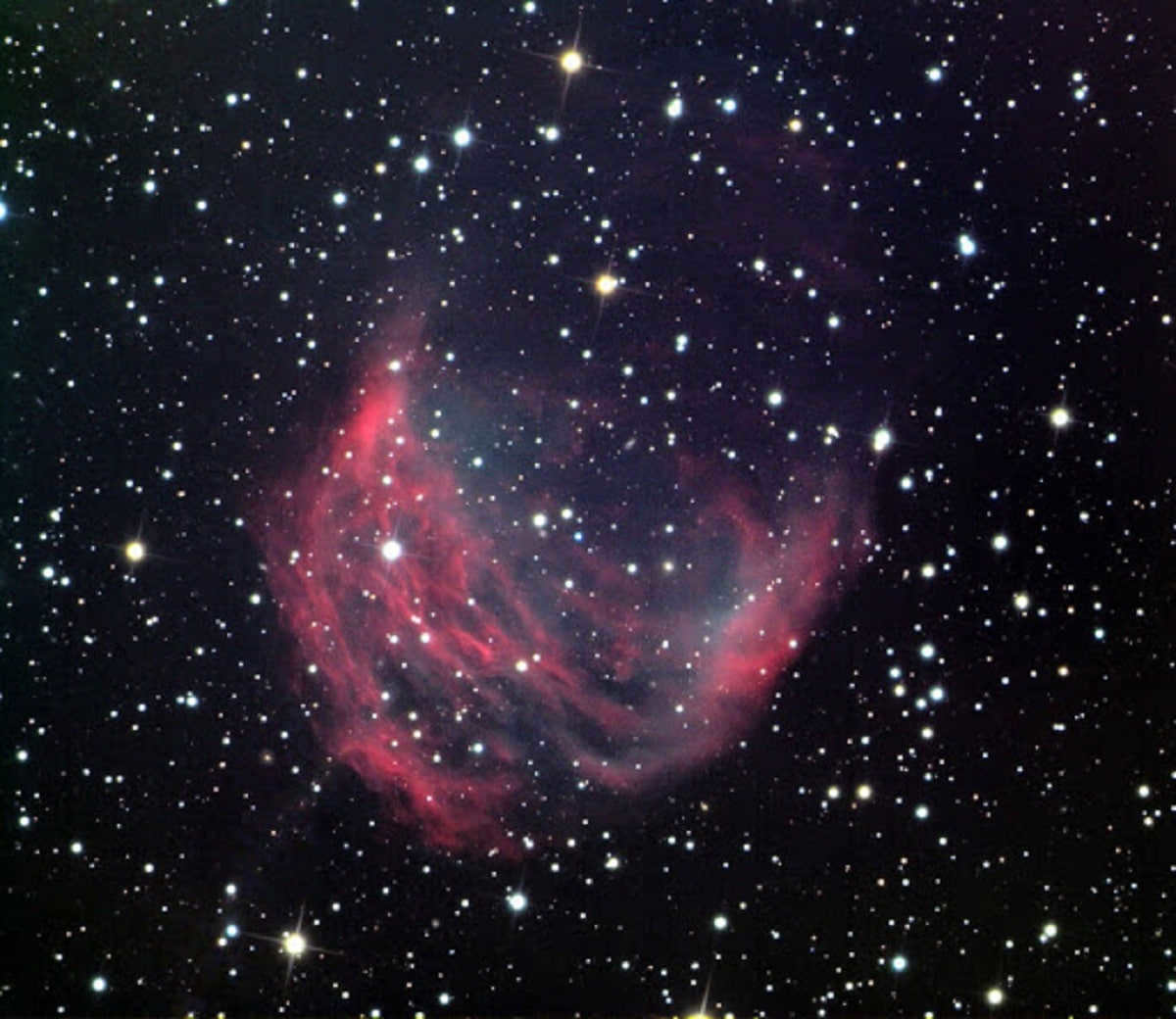
The origin of the name Gemini is said to be derived from the monikers of two mischievous and contrasting twins, Castor and Pollux. These twins typically appear as two unclothed young children. In Roman mythology, they are associated with Romulus and Remus, the fabled founders of Rome.
The twins are believed to have hatched from the eggs of Leda, a queen from Sparta. After mating with Zeus in the form of a swan, Castor met his demise as a youth, prompting Pollux to seek vengeance for his brother’s death. When Zeus descended to Earth to grant Pollux the gift of immortality, the latter declined, stating that he did not wish to live eternally without his sibling. Consequently, Zeus, seeking to appease Pollux, permitted him to traverse between the realm of the gods and the realm of the deceased in order to visit his brother.
Astrology
In the realm of astrology, Gemini is classified as one of the zodiac’s air signs. It is widely regarded as one of the most astute and analytical constellations. Since having two minds is superior to having just one, especially when those two minds are completely contrasting. This constellation boasts numerous positive traits, while the negative ones are formidable and extreme. Self-centeredness and individualism are among their less desirable qualities. On the positive side, Geminis are highly perceptive and intelligent, exerting a significant influence on their surroundings and displaying a remarkable adaptability to their environment.
Star clusters
In the Gemini constellation, there are star clusters known as dispersed star clusters or galaxy clusters. These clusters are composed of molecular clouds and are scattered throughout the galaxy.
These star clusters consist of a large number of very hot stars. They can only be found in spiral galaxies and are essential for studying star formation in the Milky Way because the stars within them are of similar age and composition.
In addition to star clusters, the Gemini constellation also contains formations called nebulae. One notable nebula is the Eskimo Nebula, which gets its name from its resemblance to a man’s face covered with a hood, similar to how Eskimos cover their heads.
With this information, you can now explore more about the Gemini constellation and its unique characteristics.
Check out the complete article: Network Meteorology " astronomy " Gemini constellation
Astronomers have long been fascinated by the celestial formations created by clusters of bright stars, which were named constellations in ancient times. These constellations were often associated with captivating legends and important prophecies. One particularly intriguing constellation is Gemini. This article will provide fascinating insights and remarkable information about the Gemini constellation.

Description of the constellation
The constellation Gemini can be described as a section of the starry sky that is positioned perpendicular to the Milky Way. Its luminaries create the shape of an almost perfect rectangle. On a clear night, approximately seventy stars are visible to the naked eye. The two brightest stars in this constellation are known as Castor, also referred to as the “coachman,” and Pollux, also known as the “fist fighter.” The other stars in Gemini form two parallel chains. However, contrary to the images often depicted in ancient star atlases, there is no clear depiction of twin brothers embracing each other in the night sky. This image is not represented in modern constellation charts either.

Fascinating entities in the Gemini constellation
The Gemini constellation is home to a plethora of captivating entities. Some of these entities are visible to the naked eye, drawing the attention of scientists due to their frequent transformations. One such object is the U (ipsilon) of Gemini, which possesses extraordinary properties. This entity is classified as a variable cipheid, meaning it periodically alters its luminosity. These fluctuations occur approximately every 102 days and are caused by powerful explosions transpiring on its surface. By examining constellation diagrams closely, one can discern that this star occupies the designated position for the “heart” of Pollux.

Fascinating items. Shooting stars and celestial clouds
In the vicinity of Castor in the Gemini constellation lies the radiant point of a meteor shower called the Geminids. This spectacular event can be witnessed from December 7th to December 15th, with the peak activity occurring on the 13th. During this time, the number of shooting stars can reach up to 60 per hour.
In close proximity to the stars Mu and Zeta Gemini, one can observe a faint celestial object visible to the naked eye. This object is actually a star cluster (M35) consisting of 120 stars, which presents an intriguing spectacle when observed through a telescope or binoculars. Situated at a distance of 830 parsecs from the Sun, it offers a captivating view.
Another captivating entity worth exploring is the Clown Nebula, also known as the Eskimo Nebula (NGC 2392). These imaginative names have been bestowed upon a tenth magnitude star encircled by a visually striking and uniform dust shell. Located approximately 2900 light years away from the Sun, it provides a captivating sight.
Throughout history, celestial navigation has played a crucial role in guiding travelers and explorers. Various cultures have assigned different names to the stars that light up the night sky. Nevertheless, two prominent stars, situated close to one another, have always been perceived as inseparable. According to Greek mythology, the constellation Gemini tells the tale of these stars, known as the brothers Castor and Pollux (Polydevcus), who are the offspring of the Spartan king Tyndareus and the Olympian deity Zeus. This particular region of the celestial sphere is documented in the astronomical compendium “Almagest,” compiled by Claudius Ptolemy in 140 AD. The ancient Babylonians also regarded this constellation as an inseparable duo, referring to its brightest stars as the “shepherd and warrior.” The Thracians believed that these stars were twins and provided guidance to seafarers in finding their way back home.

Observation
How can you locate the constellation Gemini in the night sky? This can be a challenging task for children, but it’s actually quite simple. The constellation stands out prominently with its unique pattern. Gemini is composed of two parallel chains of stars and can be found northeast of Orion. The “parachute” of the Ascendant constellation should be northwest in this case. Gemini is part of the group of prominent constellations in the sky, moving westward after Taurus and slightly ahead of Leo, which is moving eastward.
You can have a clear view of what the Gemini constellation looks like in January and December. Every year on June 21, the Sun enters Gemini, making it high above the horizon and visible throughout our entire country.

Mythology. Tales of Heroic Exploits
The mythology surrounding the constellation of Gemini recounts a story of two brothers who grew up to be exceptional athletes. They accomplished numerous renowned feats. The Dioscuri, as they were called, aided Jason in his quest to obtain the coveted golden fleece. Castor displayed unmatched skill as a charioteer, while Pollux earned a reputation as an invincible pugilist. The brothers were inseparable and always worked together. On one occasion, they even daringly abducted their own sisters, Theba and Helaiera, who were the daughters of King Livkippus. The brothers managed to steal the girls right from under the king’s nose and wed them themselves. Polydevk chose Pheba as his bride, while Castor selected Gelaira. This act of betrayal, however, led to the brothers’ sworn enmity with Apharetides (Idas and Linkeus), the brothers of the stolen brides. In a tragic turn of events, Castor was eventually killed by Idas in a fierce battle.

Mythology. The Bond of Brothers
The celestial formation known as Gemini came into existence through a captivating tale of brotherly love. This particular part of the narrative holds great significance for young ones, as it showcases the essence of selfless affection between siblings. Following Castor’s demise, Polydevk beseeched Zeus to grant him mortality. The courageous hero was willing to reside in the depths of Hades, never to be separated from his beloved brother. The Thunderer felt remorseful about subjecting his son to such a gloomy fate. Thus, he granted Polydeucus’ request, but with the condition that he spend one day in Olympus and another in the realm of the dead. The ancient Greeks revered these inseparable twins as guardians and champions of humanity. Witnessing the unwavering bond between Polydeucus and Castor, Zeus transformed them into celestial bodies and positioned them in the heavens as a reminder of their unwavering loyalty and brotherly love.
Our article aims to provide a brief description of the Gemini constellation. This information is particularly beneficial for children as it helps them broaden their knowledge and enhance their understanding of the world around them. The inclusion of ancient myths adds a poetic touch to the study of the starry sky. Embark on the journey of studying astronomy and unlock a multitude of thrilling discoveries!
Gemini, one of the zodiacal constellations, has been known to humanity since ancient times. It is prominently visible in the Northern Hemisphere from December to May. On clear and cloudless nights, you can observe up to 70 stars, with Pollux and Castor being the most luminous ones.
The Greek mythological figures Castor and Pollux, known as the Dioscurus twins, played important roles in various events such as the Argonauts’ campaign, the Calydonian Hunt, and the Olympic Games organized by Heracles. In ancient Greece, they were revered as the protectors of seafarers and the patrons of warriors, while in Rome, they symbolized military courage.
The constellation of Castor and Pollux was well-known in ancient times and was mentioned in Claudius Ptolemy’s “Almagest.” According to legend, Zeus placed the constellation in the sky to ensure that the brothers would never be separated. These stars were often compared to the Gemini constellation, both by the ancient Greeks and the Arabs. The star Pollux was referred to as “the head of the second twin.”
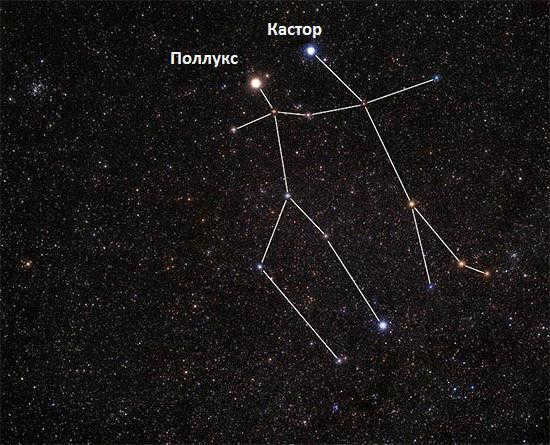
Alpha Gemini
Castor (α Gem) is the dominant and second most luminous star in the constellation Gemini. It is classified as an A2Vm star, which is a blue main-sequence star. Its size is nearly three times that of the Sun and its temperature is approximately 9000 Kelvin. It is situated 50 light-years away from Earth. The apparent magnitude of Castor is 1.58, while its absolute magnitude is -0.59/0.61. Notably, a lower numerical value indicates a higher magnitude.
The star Castor is actually a multiple star system, a discovery made in the 17th century. Subsequently, it was revealed that it is not just a binary star, but a system composed of three components, each of which is a double star in terms of its spectral characteristics. The largest member of the system is Castor a, which is directly linked to Castor b. The two stars orbit each other with a period of approximately 350 years.
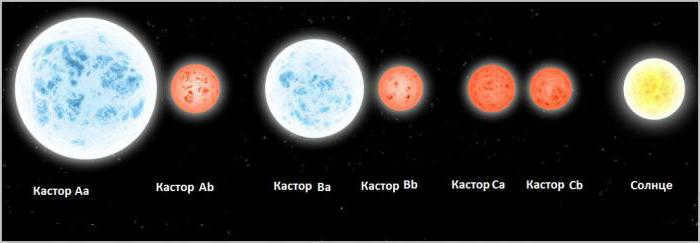
There exists a celestial phenomenon referred to as the “Castor star moving group.” This group consists of a collection of 15 stars that are gravitationally bound to Alpha Gemini and travel together in the same direction. Although they vary in size, these stars share a common origin and are nearly the same age. Among the members of the Castor group are Vega, Fomalgaut, k Phoenix, α Cepheus, 14 Hare, several stars in Libra, and Gliese.
The practice of assigning Greek letters to stars based on their apparent brightness was introduced by Johann Bayer, an astronomer who lived during the 16th and 17th centuries. According to Bayer’s system, the older the letter in the Greek alphabet, the more brilliant the star appears in the sky. As a result, the alpha star is the most prominent, with subsequent stars descending in brilliance.
However, this classification does not hold true for Pollux. Despite being one of the brightest stars in the sky and the brightest in the Gemini constellation, it is listed as “beta” and not “alpha.” This is because Pollux is positioned to the south of Castor in the ecliptic coordinate system.
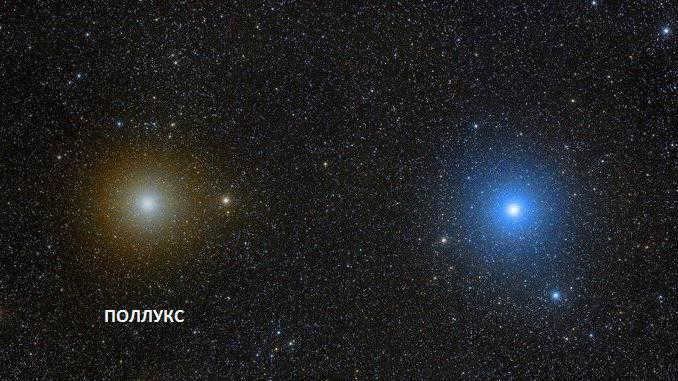
Out of all the visible celestial bodies in the nocturnal expanse, the 17th position in terms of luminosity is occupied by the star Pollux. As a result, it outshines Alpha Leo, South Pisces, Swan, and even Beta of the Southern Cross. It is possible to observe Pollux with the unaided eye, without the need for any additional optical instruments.
Attributes of Pollux
Pollux is an orange giant and falls under the spectral class K0 IIIb. It has a temperature of 4865 degrees Kelvin and an absolute stellar magnitude of 1.09. These particular characteristics are indicative of Pollux being in its final stages of evolution.
Currently, Pollux’s luminosity is 32 times greater than that of the Sun, and it is located approximately forty light years away from us. It is believed to be a variable star, meaning its luminosity is not consistent and fluctuates between 1.10 m and 1.17 m. A team of scientists discovered the presence of an exoplanet in Pollux’s orbit eleven years ago, and this planet completes one orbit around it every 590 days, equivalent to the duration of 590 Earth days.
Aside from Pollux and Castor in the constellation Gemini, there are an additional 12 stars that are brighter than the third magnitude. There are also several dozen more stars with magnitudes brighter than 6.5 m. Approximately four of these stars have been found to have planets. Gemini is an excellent constellation for observation, as many of its objects can be seen without the need for a telescope. For example, you can easily spot the orange k Gemini alongside its green-colored companion or the spectral double Alchena.
Another fascinating star that can be seen with the naked eye is Eta Gemini, also known as Propus. It is a triple star system with a period of 2,983 Earth days. It is located 380 light years away from the Sun. Eta Gemini has a variable luminosity that ranges from 3.1 m to Z.9 m. The transition between these values can be observed over a period of 233 days.
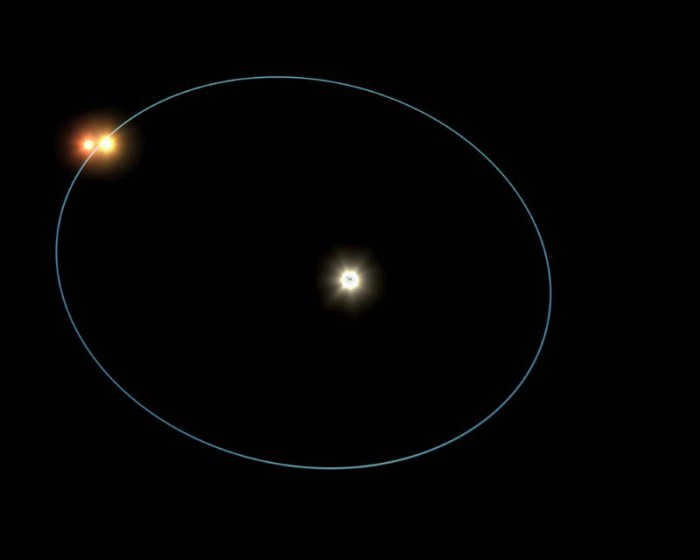
The star HD 50692, also known as 37 Gemini, is a G-type main-sequence star similar to our Sun. It is located approximately 56 light-years away from Earth. With an age of over 5.5 billion years, it is relatively old, but still younger than the Sun. The star’s mass is nearly identical to that of our Sun. In the year 2001, a transmission was sent from the Crimean radar to the HD 50692 system. This message is expected to reach its intended destination in 2057.
From December 4th to 17th, there is a meteor stream called Geminid near the star Castor. This meteor stream gets its name from the Latin name of the constellation Gemini. The Geminid meteor stream has been known since the 19th century. The meteors in this stream have an average speed of 35 km/h. These meteors are not very large, as they move in the same direction as the Earth.
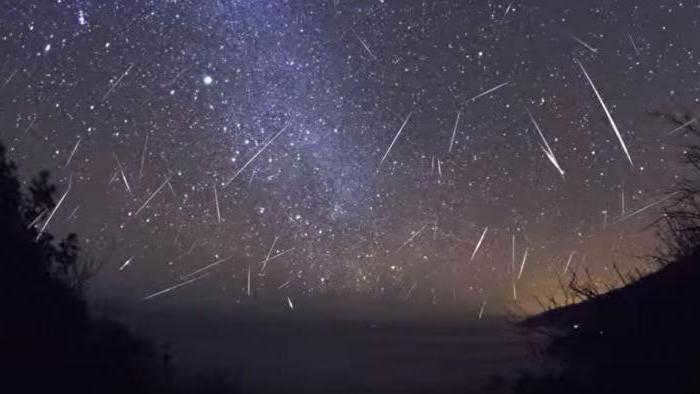
The Geminids are known for being one of the most potent meteor showers, often displaying stunning bright bolides and meteors. Its peak occurs on December 13-14, during which approximately one hundred meteors can be observed per hour. However, in 2011, the rate doubled, with a record-breaking 200 meteors visible every hour.

The constellation Gemini, located in the northern hemisphere, follows Taurus and is surrounded by Cancer, Unicorn, Orion, and other constellations. With a size of only 514 square degrees, it ranks thirtieth among all areas of the starry sky.
Legends and Myths
Since ancient times, people have been observing the stars, leading to the creation of numerous myths and legends. Gemini is no exception to this trend.
Originally, the term “twins” likely referred to the two brightest stars – Castor and Pollux, which are associated with an intriguing legend.

Stars found in the constellation Gemini
As you may already be aware, the most prominent stars within the Gemini constellation are Castor and Pollusk. Castor is classified as an alpha star and is actually a binary system, consisting of five satellites gravitationally bound together.
Pollusk, on the other hand, is a beta star and an orange giant that shines even brighter than Castor. Interestingly, a potentially habitable exoplanet has been discovered within its orbit.
In addition to these stars, there are other notable stars within the Gemini constellation. Gamma, also known as Alchena, is a double star similar to Castor. It appears as a white subgiant with a less luminous companion.
The epsilon star of Gemini is called Mebsut and is a supergiant with a mass 19 times that of our Sun.
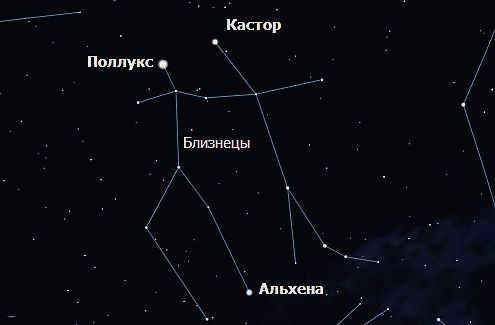
The red giant known as Teyat is Mu. This star is of interest because it is considered a singular star, but it can actually be part of a binary or even trinary system.
And what is definitely a trinary star is Propus, an Eta Gemini consisting of a binary system and a dwarf. Its name literally translates to “front foot.”
Xi of the twins is a yellow-white subgiant that is easily visible to the naked eye, even in urban areas around the world, except for regions close to the South Pole.
Another yellow-white subgiant in Gemini is Delta called Wasat. The name is somewhat controversial, as it translates to “middle.” It is unclear what exactly this star represents as average.
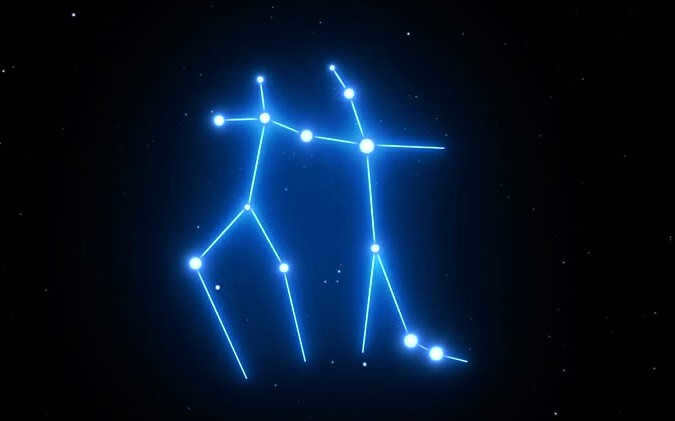
Other celestial objects
The Gemini constellation boasts not only a multitude of bright stars but also a plethora of star clusters and nebulae. One notable inclusion in the Messier catalog is the M 35 cluster. Moreover, there are both young clusters such as NGC 2129 and older clusters like NGC 2355.
In addition to star clusters, the constellation Gemini is also home to various nebulae. One particularly renowned nebula is NGC 2392, affectionately nicknamed the “Eskimo” due to its striking resemblance to a hooded human head upon its discovery. However, in August 2020, NASA, alongside other astronomical organizations, advised against using the name as it “references the colonial past.” As a result, the nebula is now simply referred to as NGC 2392.
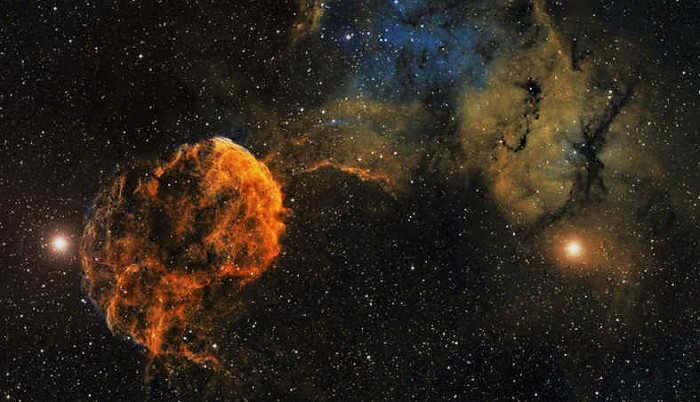
The NGC 2371 nebula in the constellation Gemini bears a visual resemblance to two distinct entities. As a result, it has been included twice in the New General Catalog.
Another intriguing entity within Gemini is the Gemini pulsar, which happens to be one of the nearest to Earth. Interestingly, at the time of its discovery, there was uncertainty regarding which category it should be classified under (the pulsations were not observed until 17 years later). Consequently, it was named Geminga, meaning “it’s not there” in the Lombard dialect.
